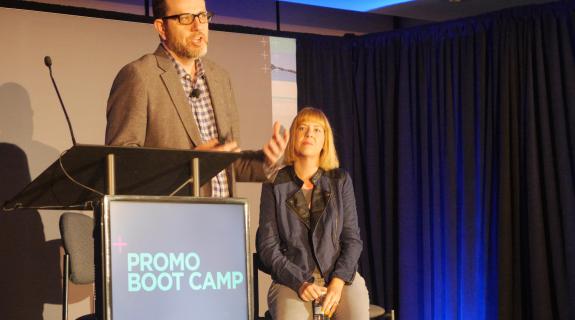[Pictured above: Murphy Gilson and Becky Wilson]
Pivot’s Murphy Gilson presented five key takeaways at his Promo Boot Camp session at The Conference 2014 in New York City on Wednesday, starting with “Human beings seek out stories” and ending with “People are delicious.”
“The better one understands narrative storytelling,” said Gilson, “the easier it is to craft a powerful, effective promo.”
In a standing-room only session during Wednesday’s Promo Boot Camp session, “Packing a Punch: Brand Storytelling Through Promo,” Gilson, SVP of brand and creative at Pivot, and We Write Good’s co-owner and creative director, Becky Wilson, broke down what makes a good promo, and perhaps more importantly, what makes a good story.
Human beings seek out stories. According to Gilson, we are just wired for a good story, but especially pattern recognition, which makes us seek out stories and sometimes see patterns where none exist.
“We share information using another set of patterns, and those patterns are called stories,” said Gilson. “We actually search for narrative arcs in our lives. We search for a beginning, middle and end.”
Speaking about story structure to the promo creators in the audience, Gilson explained that while they may only have a 10- or 15-second spot to tell an entire story or present a TV show’s narrative arc, it’s their job to create emotional experiences with their viewers and evoke a desired outcome.
“Before you even start writing your copy, you need to know what it is you want someone to do, what it is you want someone to feel.”
“Sometimes it’s so easy to get wrapped up in telling the story of the show, or the episode,” said Wilson. “But sometimes you forget that you have to tell a story within the promo. The promo is a story itself.”
The two speakers presented a few examples of storytelling that successfully evoke an emotional response within the viewer, sometimes using no words at all (also above).
And sometimes telling just hinting at the story to come:
Moving on to story structure, Gilson says promos are just like knock-knock jokes. You need to set up the premise of the world you’re creating very quickly, sometimes using a cliché that you may know is a cliché, but, according to Gilson, in the right hands clichés can be turned into good story structure.
“In a world… Meet Jack, he’s just a regular guy… We’ve all made that spot! We’ve been doing this for so long that we hate ourselves for the cliché of it, but we never realize that we’re doing good story structure.” Because in the end, the premise to a good promo needs to be clear and it needs to be quickly communicated to the audience.
“I say this not so we keep writing the same promos we’ve written since the ‘80s, said Gilson. “I want to flip the table on how we do this whole thing. But you need to know proper story structure to flip the table well.”
And in the end, less is more. You don’t need much to tell an epic story. These two speakers say that can be as little as six words.
“It takes Michael Bay three hours to tell a story about a Hasbro toy,” according to Gilson. “We can tell a story in 30 seconds.”
“Stories aren’t just a way to convey facts and figures, they’re a way to transfer that emotional experience,” said Gilson. “If you do not view what you do as a creative, as a promo creator, as storytelling, you are a failure to the species and deserve to be eaten by a dinosaur.”
TAKEAWAYS:
—Human beings seek out stories.
—Storytelling is an emotional experience.
—Every story has a structure, every promo tells a story - “Emotion over explanation” – Becky Wilson
—An epic tale can be told in six words.
—And of course: People are delicious. Especially to dinosaurs.
[Image courtesy of Tamra Raven]
Tags:













































__twocolumncontent.jpg)











